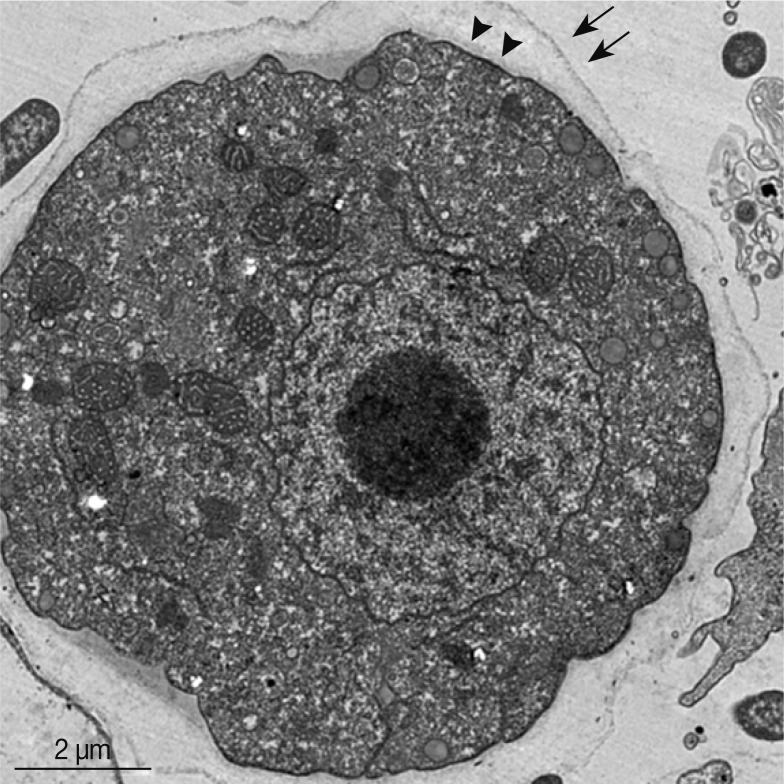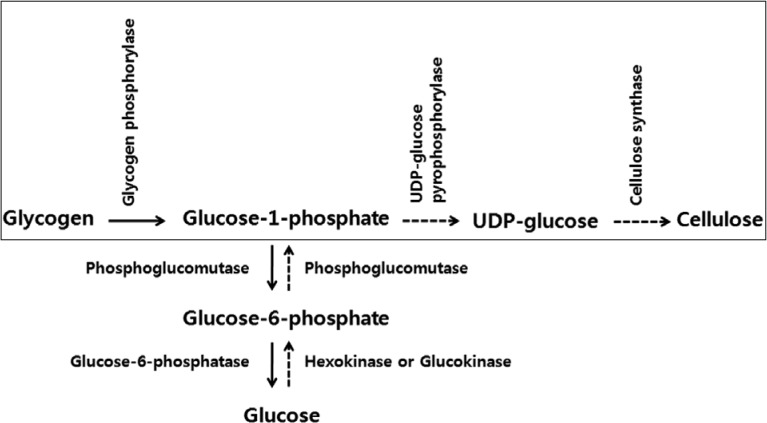Under unfavorable environmental conditions, Acanthamoeba trophozoites transform into cysts those are resistant to extreme physical and chemical conditions [1]. The mature cyst has 2 walls, an outer wall (exo-cyst) and an inner wall (endo-cyst) (Fig. 1). The cyst wall of Acanthamoeba castellanii contains carbohydrates (35%), protein (33%), ash (8%), lipid (4-6%), and unidentified materials (20%) [2]. Acid-resistant proteins and cellulose are the major components of the cyst wall [3]. The precursor of cellulose is glucose, and the source of glucose is glycogen in encysting amoeba [4]. According to the previous report, the glycogen molecule undergoes rapid degradation during the early phase of Acanthamoeba encystation, and the glycogen content of cysts is significantly less (18 µg/106 cells) than that of trophozoites (83 µg/106 cells) [4]. These results suggest the involvement of glycogen metabolism in cellulose synthesis during encystation of Acanthamoeba. However, the metabolic pathway of glycogen breakdown and cellulose synthesis during encystation has yet to be clarified. In this study, we hypothesized that the short-cut process of cellulose synthesis could be involved in rapid construction of the cyst wall of encysting Acanthamoeba. To conduct this study, A. castellanii Castellani (ATCC no. 30011) was used for induction of cysts, and comparison of ESTs and microarray analysis [7,8]. Real-time PCR analysis was performed to compare the expression levels of 3 enzymes involved in glycogen degradation and cellulose synthesis. Three sets of primers were used (Table 1), and 18s rDNA was used as a reference gene [8].
Fig. 2 shows the metabolic pathway of glycogen degradation (arrow pathway) and cellulose synthesis (dot-arrow pathway). In general, breakdown of glycogen into units of glucose occurs through phosphorylitic cleavage by glycogen phosphorylase, phosphoglucomutase, and glucose-6-phosphatase [5]. Synthesis of cellulose from glucose is also a multi-step process involving 4 enzymes; hexokinase, phosphoglucomutase, UDP-glucose pyrophosphorylase, and cellulose synthase [6]. According to the process, it is 7 steps from glycogen to cellulose in Acanthamoeba. Glucose-1-phosphate is a metabolic product of glycogen in glycogenolysis and converts to glucose through glucose-6-phosphate. For cellulose synthesis, glucose-1-phosphate is also an important branch point to generate cellulose from glucose (Fig. 2). Therefore, we hypothesized that the short-cut process of cellular synthesis from glycogen could be mediated by 3 enzymes in Acanthamoeba (Fig. 2, box).
Our previous ESTs analysis study provided partial sequences of glycogen phosphorylase (GenBank no. JX312797) and UDP-glucose pyrophosphorylase (GenBank no. JX312798) [7]. Using sequence information on cellulose synthase from A. castellanii Neff (Tang et al., unpublished), we cloned a partial cDNA of cellulose synthase from A. castellanii Castellani (GenBank no. JX312799). Results of cDNA microarray analysis between cysts and trophozoites indicated a 2.44-fold higher expression of glycogen phosphorylase in cysts than in trophozoites [8]. However, phosphoglucomutase was expressed less in cysts than in trophozoites (2.4-fold) [8]. These results suggested that the conversion of glucose-1-phosphate to glucose-6-phosphate is not essential in glycogen degradation during encystation of Acanthamoeba. Then, it is possible to hypothesize the short process to synthesize cellulose from glycogen through glucose-1-phosphate, an important branch point.
The results of the quantitative real-time PCR analysis of expression of 3 enzymes supported our hypothesis strongly. As shown in Fig. 3, the mRNA level of glycogen phosphorylase showed a gradual increase and reached the maximum (10.3-fold) at the third day after induction of encystation (Fig. 3A). Dictyostelium discoideum, a species of soil-living amoeba, has been reported to have 2 forms of glycogen phosphorylase [9]. The 2 forms of the enzyme may play different roles in the development of Dictyostelium because they have different expression patterns. Glycogen phosphorylase 1 was found to be functional during differentiation of Dictyostelium into spores which have walls containing cellulose [10]. During the time course of development of Dictyostelium, the 'b' form (glycogen phosphorylase 2) showed a decrease, whereas the 'a' form (glycogen phosphorylase 1) showed an increase [11]. The partial glycogen phosphorylase of A. castellanii Castellani showed 65% similarity with glycogen phosphorylase 1 of D. discoideum, and showed high expression during encystation. The mRNA levels of UDP-glucose pyrophosphorylase of Acanthamoeba showed the highest expression (6.1-fold) on the second day after induction of encystation (Fig. 3B). UDP-glucose pyrophosphorylase 2 of D. discoideum was required for the differentiation and development of the amoeba [12]. The partial UDP-glucose pyrophosphorylase of A. castellanii showed 62% similarity with UDP-glucose pyrophosphorylase 2 of D. discoideum. The expression level of cellulose synthase of A. castellanii showed an increase (3.0-fold) on the second day after induction of encystation (Fig. 3C). The partial sequence of cellulose synthase of A. castellanii showed 99% similarity with that of A. castellanii Neff (ACC008015- Tang et al., unpublished) and 64% similarity with that of D. discoideum. These results suggest the involvement of these enzymes in the encystation process of Acanthamoeba.
The development of the acid-insoluble protein containing ectocyst wall and the cellulose containing endocyst wall leads to emergence of resistance to biocides in encysted Acanthamoeba [13]. Cellulose, the primary component of the cyst wall, is also used for diagnosis of Acanthamoeba cysts [14]. This is the first study that we identified 3 enzymes involving cellulose synthesis in Acanthamoeba and confirm the short-cut pathway to synthesize cellulose by analysis of their expression patterns during encystation. Information on cellulose synthesis is important to understand the mechanism of encystation and to diagnose cyst-forming protozoa. This key process of cellulose synthesis may aid in understanding of cyst wall formation in Acanthamoeba.









